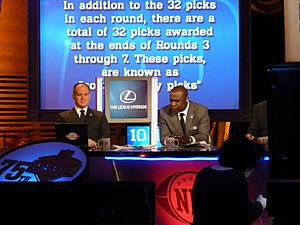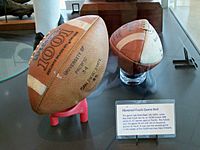Marshall Faulk facts for kids

Faulk in 2023
|
|||||||||||||
| Colorado Buffaloes | |||||||||||||
|---|---|---|---|---|---|---|---|---|---|---|---|---|---|
| Position: | Running backs coach | ||||||||||||
| Personal information | |||||||||||||
| Born: | February 26, 1973 New Orleans, Louisiana, U.S. |
||||||||||||
| Height: | 5 ft 10 in (1.78 m) | ||||||||||||
| Weight: | 211 lb (96 kg) | ||||||||||||
| Career information | |||||||||||||
| High school: | G. W. Carver (New Orleans) | ||||||||||||
| College: | San Diego State (1991–1993) | ||||||||||||
| NFL Draft: | 1994 / Round: 1 / Pick: 2 | ||||||||||||
| Career history | |||||||||||||
| As player: | |||||||||||||
|
|||||||||||||
| As coach: | |||||||||||||
|
|||||||||||||
| Career highlights and awards | |||||||||||||
|
|||||||||||||
| Career NFL statistics | |||||||||||||
|
|||||||||||||
| Player stats at PFR | |||||||||||||
|
Pro Football Hall of Fame
|
|||||||||||||
|
College Football Hall of Fame
|
|||||||||||||
Marshall William Faulk (born February 26, 1973) is a famous American former football player. He was a running back in the National Football League (NFL) for 12 seasons. Many people think he is one of the best running backs ever. As of 2025, he is the running backs coach at the University of Colorado.
Faulk played college football for the San Diego State Aztecs. He was chosen as an All-American twice. The Indianapolis Colts picked him second overall in the 1994 NFL draft. He played with the Colts for five seasons. Then, he spent his last eight seasons with the St. Louis Rams. Faulk was a key player for the "The Greatest Show on Turf" Rams team. This team went to two Super Bowls and won Super Bowl XXXIV.
He won the AP NFL Offensive Player of the Year award three times in a row. This tied a record with Earl Campbell. Faulk was also named the NFL Most Valuable Player (MVP) in the 2000 season. He is one of only three NFL players to have at least 10,000 rushing yards and 5,000 receiving yards. He is the only player with over 12,000 rushing yards and 6,000 receiving yards. Faulk was inducted into the Pro Football Hall of Fame in 2011. He also joined the College Football Hall of Fame in 2017.
Contents
Early Life and High School Football
Marshall Faulk was born and grew up in New Orleans, Louisiana. He went to Carver High School. There, he played for the Carver Rams high school football team.
Faulk was also a great track sprinter. He could run 100 meters in 10.3 seconds. In his last two years at Carver High, he rushed for 1,800 yards. He also scored 32 touchdowns. In his senior year, he played defensive back too. He caught 11 interceptions and returned six for touchdowns.
College Football Career
Many big colleges wanted Faulk to play for them. However, most wanted him as a cornerback. Faulk really wanted to be a running back. He knew he would be more successful doing what he loved. He chose San Diego State University because they offered him a scholarship to play running back.
One of his best college games was on September 14, 1991. It was only his second college game. He ran for 386 yards and scored seven touchdowns. Both were records for a freshman. This amazing game started one of the best freshman seasons in NCAA history. He gained 1,429 rushing yards and scored 23 touchdowns. Faulk became one of only three true freshmen to be named an All-American.
Faulk continued to play well in his sophomore year. He rushed for over 1,600 yards. In his junior year (1993), he showed he could do it all. He caught 47 passes for 640 yards and 3 touchdowns. He also rushed for 1,530 yards and 21 touchdowns. Faulk left San Diego State with many school records. He had 5,562 all-purpose yards and 62 career touchdowns. This is the 8th most in NCAA history.
In 1992, Faulk finished second in the Heisman Trophy voting. This award goes to the most outstanding player in college football.
Professional Football Career
Joining the Indianapolis Colts (1994–1998)
The Indianapolis Colts picked Marshall Faulk second overall in the 1994 NFL draft. The Colts really needed a strong running game. In July 1994, Faulk signed a big contract.
He quickly made an impact, rushing for 1,282 yards and 11 touchdowns in his first year. The Colts improved their record to 8 wins and 8 losses. Faulk became the first NFL player to win both the NFL Offensive Rookie of the Year award and the Pro Bowl's Most Valuable Player award in the same season. He was also the first rookie to win Pro Bowl MVP.
In his second season, Faulk rushed for 1,078 yards and 14 total touchdowns. The Colts made it to the playoffs. They almost reached the Super Bowl but lost a close game to the Pittsburgh Steelers. Faulk missed that game due to a toe injury.
The next year, Faulk struggled with a toe injury. He rushed for only 587 yards. He recovered and rushed for over 1,000 yards in the next two seasons. In 1998, he set a personal best with 1,319 rushing yards. He also caught 86 passes for 906 yards. He led the NFL in total yards from scrimmage with 2,227. This was the first of his NFL-record four straight seasons with over 2,000 total yards.
St. Louis Rams and "The Greatest Show on Turf" (1999–2006)
In 1999, Faulk was traded to the St. Louis Rams. He signed a large contract with them. In his first year with the Rams, Faulk was a key player for "The Greatest Show on Turf" offense. This offense was known for its fast and exciting plays.
Faulk set an NFL record with 2,429 total yards from scrimmage. He rushed for 1,381 yards and caught 1,048 receiving yards. He also scored 12 touchdowns. Faulk became only the second player at that time to have over 1,000 rushing yards and 1,000 receiving yards in one season. The Rams went on to win Super Bowl XXXIV. In the Super Bowl, Faulk had 5 catches for 90 yards. He received the NFL Offensive Player of the Year Award that season.
The next year (2000), Faulk became the first running back to lead his team in receptions for five different seasons. He was also named the NFL MVP and NFL Offensive Player of the Year again. He rushed for 1,359 yards and set a new NFL record with 26 total touchdowns.
In 2001, the Rams returned to the Super Bowl. They lost a close game to the New England Patriots. Faulk had another excellent season. He rushed for a career-high 1,382 yards and caught 83 passes for 765 yards. He led the NFC with 2,147 total yards from scrimmage and scored 21 touchdowns. Faulk won the NFL's Offensive Player of the Year award for the third year in a row.
After 2001, Faulk's injuries and age started to affect his play. He was still a respected player, but he didn't have as many rushing yards. In 2004, he shared playing time with rookie Steven Jackson. The 2005 season was Faulk's last in the NFL. He rushed for 292 yards and caught 44 passes. This was the only time in his career he didn't have a rushing touchdown.
Injuries and Retirement
In July 2006, the Rams announced that Faulk would miss the entire season due to knee surgery. During that time, Faulk worked as an analyst for the NFL Network.
On March 26, 2007, Marshall Faulk officially announced his retirement from football. In November 2007, the Rams decided to retire Faulk's jersey number. This means no other player on the Rams will wear his number 28. The ceremony happened on December 20, 2007.
In 2011, Marshall Faulk was elected into the Pro Football Hall of Fame in his first year of eligibility. He is known for his amazing receiving yards (6,875), pass receptions (767), and total yards from scrimmage (19,154).
NFL Records
Marshall Faulk holds several impressive NFL records:
- Fastest player to gain 16,000 and 17,000 yards from scrimmage.
- Most two-point conversions in a career (7).
- Most consecutive seasons with 2,000 yards from scrimmage (4).
- Most receiving yards by a running back in a season (1,048).
- Only player with 70+ rushing touchdowns and 30+ receiving touchdowns.
- Only player with 12,000 rushing yards and 6,000 receiving yards in a career.
Awards and Honors
NFL Awards
- Super Bowl champion (XXXIV)
- NFL Most Valuable Player (2000)
- 3× NFL Offensive Player of the Year (1999–2001)
- NFL Offensive Rookie of the Year (1994)
- 3× First-team All-Pro (1999–2001)
- 7× Pro Bowl (1994, 1995, 1998–2002)
- NFL rushing touchdowns leader (2000)
- 2× NFL scoring leader (2000, 2001)
- Indianapolis Colts Ring of Honor
- Los Angeles Rams No. 28 retired
College Awards
- WAC Offensive Player of the Year (1992)
- 3× First-team All-American (1991–1993)
- San Diego State Aztecs No. 28 retired
Post-NFL Career

After retiring from playing, Faulk worked as an analyst for NFL Network. He shared his insights on the game from a player's point of view.
Faulk was inducted into the Pro Football Hall of Fame in 2011. He was also inducted into the Indianapolis Colts Ring of Honor in 2013.
Coaching Career
On February 6, 2025, Marshall Faulk was hired as the running backs coach for the Colorado Buffaloes football team.
Personal Life
Marshall Faulk has six children. His son, Marshall Faulk Jr., also played running back in college.
Faulk has a charity foundation in San Diego. He is also a cousin of Kevin Faulk, another former NFL running back. In 2009, Faulk was inducted into the San Diego Hall of Champions.
See also
- List of National Football League career rushing yards leaders
- List of National Football League career all-purpose yards leaders


